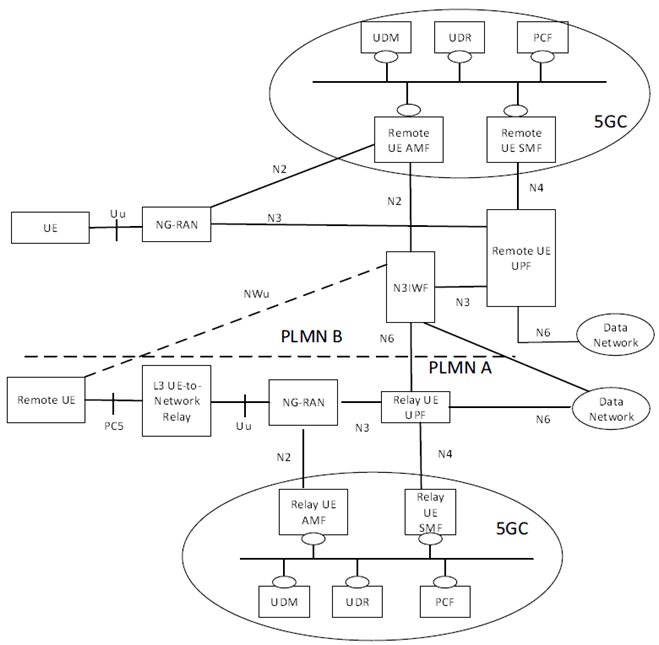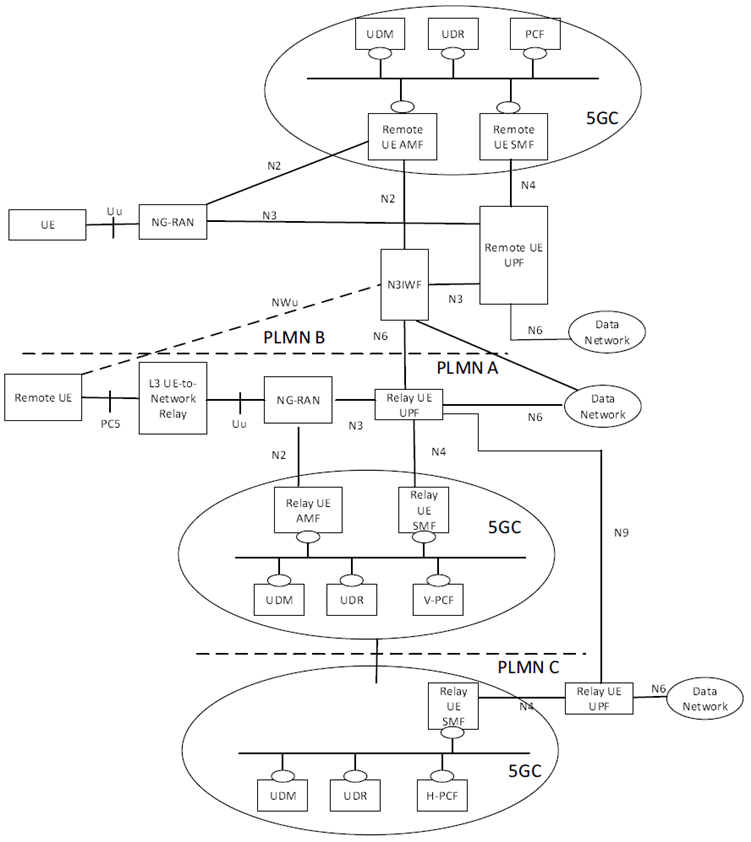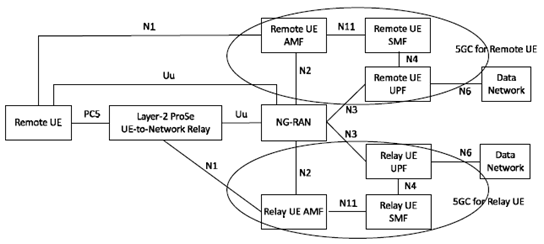Content for TS 23.304 Word version: 19.0.0
1…
4…
4.2.3…
4.2.7…
4.3…
5…
5.1.4…
5.1.5…
5.2…
5.3…
5.4…
5.5…
5.6…
5.7
5.8…
5.9…
6…
6.1.2…
6.2…
6.3…
6.3.2…
6.3.2.3…
6.3.2.4…
6.4…
6.4.3…
6.5…
6.5.2…
6.6…
6.7…
6.7.2…
6.8…
7…
7.2…
4.2.7 5G ProSe UE-to-Network Relay reference architecture
4.2.7.1 5G ProSe Layer-3 UE-to-Network Relay reference architecture
4.2.7.2 5G ProSe Layer-2 UE-to-Network Relay reference architecture
4.2.8 5G ProSe UE-to-UE Relay reference architecture
4.2.9 Support for 5G ProSe in NPNs
...
...
4.2.7 5G ProSe UE-to-Network Relay reference architecture p. 21
4.2.7.1 5G ProSe Layer-3 UE-to-Network Relay reference architecture p. 21
The following Figure 4.2.7.1-1 shows the high level reference architecture for 5G ProSe Layer-3 UE-to-Network Relay. In this Figure, the 5G ProSe Layer-3 UE-to-Network Relay may be in the HPLMN or a VPLMN.

Figure 4.2.7.1-1: Reference architecture for 5G ProSe Layer-3 UE-to-Network Relay
(⇒ copy of original 3GPP image)
(⇒ copy of original 3GPP image)
The following Figure 4.2.7.1-2 shows the non-roaming reference architecture for 5G ProSe Layer-3 UE-to-Network Relay when N3IWF is supported. In this Figure, the PLMN A and PLMN B may be the same or different. When the 5G ProSe Layer-3 Remote UE may connect to NG-RAN directly to access PLMN B and in that case it would take the role of UE in the Figure. The N3IWF may be connected to Relay UE UPF via a Data Network.

Figure 4.2.7.1-2: Non-roaming architecture model for 5G ProSe Layer-3 UE-to-Network Relay with N3IWF support
(⇒ copy of original 3GPP image)
(⇒ copy of original 3GPP image)
The following Figure 4.2.7.1-3 shows the roaming reference architecture for 5G ProSe Layer-3 UE-to-Network Relay. In this Figure, the PLMN A and PLMN B may be the same or different and/or the PLMN A and PLMN C may be the same or different. The N3IWF may be connected to Relay UE UPF via a Data Network.

Figure 4.2.7.1-3: Roaming architecture model for 5G ProSe Layer-3 UE-to-Network Relay with N3IWF support
(⇒ copy of original 3GPP image)
(⇒ copy of original 3GPP image)
4.2.7.2 5G ProSe Layer-2 UE-to-Network Relay reference architecture p. 23
Figure 4.2.7.2-1 shows the 5G ProSe Layer-2 UE-to-Network Relay reference architecture. The 5G ProSe Layer-2 Remote UE and 5G ProSe Layer-2 UE-to-Network Relay may be served by the same or different PLMNs. If the serving PLMNs of the 5G ProSe Layer-2 Remote UE and the 5G ProSe Layer-2UE-to-Network Relay are different then NG-RAN is shared by the serving PLMNs, see the 5G MOCN architecture in clause 5.18 of TS 23.501.

Figure 4.2.7.2-1: 5G ProSe Layer-2 UE-to-Network Relay reference architecture
(⇒ copy of original 3GPP image)
(⇒ copy of original 3GPP image)
4.2.8 5G ProSe UE-to-UE Relay reference architecture |R18| p. 24
Figure 4.2.8-1 shows the Layer-2 and Layer-3 5G ProSe UE-to-UE Relay reference architecture. The 5G ProSe End UEs communicate with each other via a 5G ProSe UE-to-UE Relay.

Each 5G ProSe End UE and the 5G ProSe UE-to-UE Relay may have subscriptions from the same PLMN or different PLMNs.
4.2.9 Support for 5G ProSe in NPNs |R19| p. 24
4.2.9.1 Support for 5G ProSe in SNPN p. 24
The proximity based services defined in this specification are applicable to SNPN(s) with the following adaptations:
- The non-roaming architecture in clause 4.2.1 is applicable also to SNPN, whereby the term PLMN is replaced by subscribed SNPN.
- The roaming architecture in clause 4.2.2 is not supported.
- Inter-SNPN operation in clause 4.2.3 is not supported.
-
For 5G ProSe Direct Discovery, the procedures in clauses 5.2 and 6, the network function services in clause 7, and the identifiers as specified in clause 5.8.1 are used with the following adaptations:
- The concept of Local PLMN for direct discovery is not supported.
- In the ProSe Application ID in clause 5.8.1.1 the value of PLMN ID within the ProSe Application ID shall be combined with a Network Identifier (NID) to identify an SNPN.
- The ProSe Application Code in clause 5.8.1.4 is extended to allow the value of PLMN ID within the ProSe Application Code to be combined with a Network Identifier (NID) to identify an SNPN.
- The Announcing PLMN ID in clause 5.8.1.11 is not used in the case of SNPNs.
- The Monitored PLMN ID in clause 5.8.1.17 is ignored in the case of SNPNs.
- In the 5G ProSe Direct Discovery with 5G DDNMF procedures as specified in clause 6.3.1, the term PLMN is to be replaced by SNPN, whereby PLMN IDs shall be combined with a Network Identifier (NID) to identify an SNPN, except if it pertains to PLMN IDs of VPLMNs or Local PLMNs or Announcing PLMN IDs. The term HPLMN is to be replaced by subscribed SNPN.
- The 5G ProSe UE-to-Network Relay reference architectures for 5G ProSe Layer-2 UE-to-Network relay, 5G ProSe Layer-3 UE-to-Network relay and UE-to-UE relay in clauses 4.2.7 and 4.2.8 are supported, where only the non-roaming architecture as specified for 5G ProSe Layer-3 UE-to-Network relay in clause 4.2.7.1 is supported for SNPNs, and the PLMN A, PLMN B and PLMN C in clauses 4.2.7 are the same in case of SNPNs and are replaced by the SNPN. The term PLMN is replaced by SNPN and the term HPLMN is replaced by subscribed SNPN. The term VPLMN is not applicable to SNPNs.
-
For Authorization and Provisioning and for the subscription information of the ProSe service in NPNs, the procedures and functionality as specified in clauses 5.1 and 5.7 and 6.2 are used with the following adaptations:
- The term PLMN is replaced by SNPN. The term HPLMN is replaced by subscribed SNPN. The term VPLMN is not applicable to SNPNs. Except the subscribed SNPN, no other SNPNs are authorized to perform the 5G ProSe service (i.e. 5G ProSe Direct Discovery, 5G ProSe Direct Communication, 5G ProSe UE-to-Network Relay discovery, 5G ProSe UE-to-Network Relay communication, 5G ProSe UE-to-UE Relay discovery and 5G ProSe UE-to-UE Relay communication) over PC5 reference point.
-
For 5G ProSe Layer-2 UE-to-Network relay operation, the procedures as specified in clauses 5.4.2 and 5.4.4.2, and the identifiers as specified in clause 5.8.3 are used with the following adaptations:
- The term PLMN is replaced by SNPN.
- The 5G ProSe Layer-2 Remote UE has to operate in SNPN access mode, if it intends to access SNPN for ProSe via 5G ProSe Layer-2 UE-to-Network relay.
- The 5G ProSe UE-to-Network Relay has to operate in SNPN access mode, if it intends to access SNPN for ProSe via 5G ProSe Layer-2 UE-to-Network relay.
- The 5G ProSe Layer-2 UE-to-Network relay may participate in the 5G ProSe UE-to-Network Relay Discovery procedure for emergency service if the serving NG-RAN broadcasts ims-EmergencySupport or imsEmergencySupportForSNPN in system information as specified in TS 38.300 and TS 38.331.
- The NCGI in clause 5.8.3.3 includes the Network identifier (NID) of the SNPN together with the PLMN ID in case the serving cell is operated by an SNPN.
- The 5G ProSe Layer-2 Remote UE only selects the 5G ProSe Layer-2 UE-to-Network Relay for which the NCGI includes the subscribed SNPN of 5G ProSe Layer-2 Remote UE for non-emergency service.
-
For 5G ProSe Layer-3 UE-to-Network relay operation, the procedures as specified in clauses 5.4.1, 5.4.4.3 and 6.5, and the identifiers as specified in clause 5.8.3 apply with the following adaptations:
- The term PLMN is replaced by SNPN. The term HPLMN is replaced by subscribed SNPN. The term VPLMN is not applicable to SNPNs.
- The 5G ProSe Layer-3 UE-to-Network relay has to operate in SNPN access mode in order to relay traffic to/from an SNPN for a 5G ProSe Layer-3 Remote UE.
- The 5G ProSe Layer-3 Remote UE has to operate in SNPN access mode in order to exchange traffic to/from an SNPN via a 5G ProSe Layer-3 UE-to-Network relay.
- The NCGI in clause 5.8.3.2 includes the Network identifier (NID) of the SNPN together with the PLMN ID in case the serving cell is operated by an SNPN.
- The TAI in clause 5.8.3.2 includes the Network identifier (NID) of the SNPN together with the PLMN ID in case the serving cell is operated by an SNPN.
- The support for 5G ProSe for UEs in limited service state as specified in clause 5.9 applies whereby the term PLMN is replaced by an SNPN.
4.2.9.2 Support for 5G ProSe in conjunction with CAG in PNI-NPN p. 26
In this Release, the CAG based access control is not applicable to the 5G ProSe Layer-3 UE-to-Network Remote UE accessing the network via 5G Layer-3 ProSe Relay.
The 5G ProSe Layer-2 UE-to-Network Relay procedures in conjunction with CAG for PNI-NPN are supported with the following adaptations:
- The 5G ProSe Layer-2 UE-to-Network relay may participate in the 5G ProSe UE-to-Network Relay Discovery procedure if the 5G ProSe Layer-2 UE-to-Network relay is accessing a CAG cell in the Allowed CAG list configured on the 5G ProSe Layer-2 UE-to-Network relay.